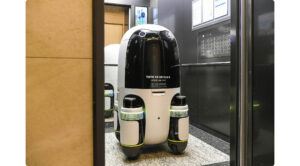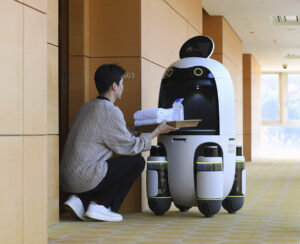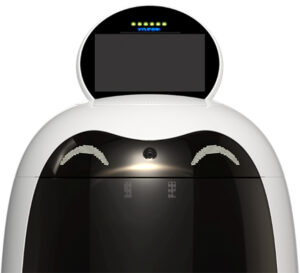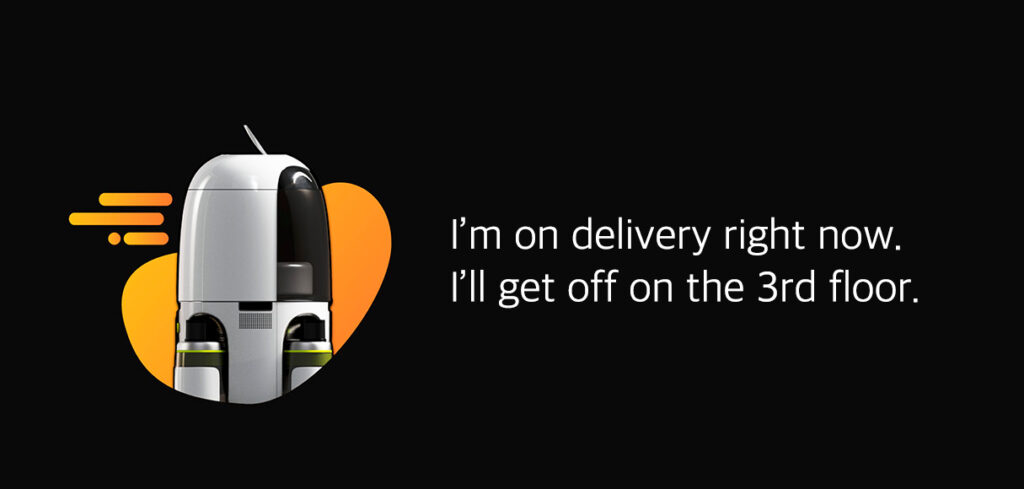Parcel and Postal Technology International speaks with Dong Jin Hyun, head of Hyundai Motor Group’s robotics lab, about the key technology behind the company’s autonomous delivery robots and their successful trial transporting meals to hotel guests.
In December 2022, Hyundai Motor Group piloted autonomous delivery robots at the Rolling Hills Hotel in Korea, where the company tested the technology’s ability to fulfill room service orders and amenity requests in a hotel setting. The robots consist of a storage unit integrated on top of a plug-and-drive (PnD) modular driving unit – Hyundai’s all-in-one mobility solution. The single-wheel units combine intelligent steering, an in-wheel electric motor, environmental awareness sensors and suspension hardware, including a steering actuator for 360° holonomic rotation. Four PnD modules ensure these indoor and outdoor delivery robots can move freely and quickly in all directions. With the addition of autonomous driving capability, the PnD-based robots can find the optimal route to deliver packages to recipients.
According to Hyun, the hotel trial has been a resounding success. “Initially, the hoteliers felt awkward about managing the robot and the autonomous delivery system, and worried about its ability to deliver efficiently, but after a few months they now entrust the robots with deliveries. Indeed, the hoteliers feel like they’ve gotten a new member. They love the customer-friendly design and the fact that the robot can take the elevator on its own, avoid obstacles and make autonomous mobile deliveries. They’re also happy that the robots can share their burden. This technology increases the business’s efficiency by letting the robots handle delivery-related tasks while people can focus on more advanced services.” The program at Rolling Hills Hotel has now been expanded as a hotel service. So how did Hyundai Motor Group create such an automation success in this consumer-dominated environment?
Smooth sailing
First, the robots were optimized for the F&B use case through attention to their smooth driving. “A suspension has been applied to the robots for safe delivery of F&B, and the robots start and brake stably and avoid obstacles smoothly while traveling to deliver the stored items safely. The payload of the delivery robot is 10kg, which is enough to deliver food.” Building lidar and camera sensors into the solution’s operations enable the robots to safely operate in the hotel. “Lidar empowers the robots to drive autonomously, see their surroundings and quickly detect and avoid obstacles on sidewalks and roads. Lidar is also essential for SLAM [simultaneous localization and mapping] technology, which generates routes and maps the environment in real time.” This mapping was performed by reading and analyzing the semantic information to distinguish areas where robots could travel outdoors. As a result, the robots can distinguish and map various areas on the road, such as sidewalks, roadways and crosswalks. They are also able to identify various obstacles on the road as well as information such as traffic lights, so they can drive safely at crosswalks.
 To support independent operation throughout the hotel, Hyundai needed to ensure that the robots could reach hotel guests staying in upstairs rooms, and that the solution could safely navigate public elevators. “Even in spaces where there is no elevator for robots, the robot can call the elevator by itself and move after boarding. When boarding the elevator, the robot recognizes if there is room on the elevator to board. If it is unable to board, the robot moves to the next elevator to enhance safety. This is to ensure that the robot can drive naturally in the space where people live and not cause any inconvenience to people’s daily lives.” Alongside this, the company built in a variety of self-sufficiency functionalities to keep its robots on the move. “Our delivery robots provide various functions – such as robot monitoring, status management, order management and real-time remote control – through cloud services and our self-developed robot control system. The robot is equipped with an automatic charging system, so if the battery is low during operation, it can charge itself and provide services again when it is fully charged.”
To support independent operation throughout the hotel, Hyundai needed to ensure that the robots could reach hotel guests staying in upstairs rooms, and that the solution could safely navigate public elevators. “Even in spaces where there is no elevator for robots, the robot can call the elevator by itself and move after boarding. When boarding the elevator, the robot recognizes if there is room on the elevator to board. If it is unable to board, the robot moves to the next elevator to enhance safety. This is to ensure that the robot can drive naturally in the space where people live and not cause any inconvenience to people’s daily lives.” Alongside this, the company built in a variety of self-sufficiency functionalities to keep its robots on the move. “Our delivery robots provide various functions – such as robot monitoring, status management, order management and real-time remote control – through cloud services and our self-developed robot control system. The robot is equipped with an automatic charging system, so if the battery is low during operation, it can charge itself and provide services again when it is fully charged.”
User-friendly design
 “Since the hotel is not a robot-friendly building,” Hyun continued, “we worked to link the robot to the hotel’s infrastructure and are now showing a rate of nearly 90%. Through continuous system upgrades and stability improvements, we are improving the delivery success rate over time.” In particular, the company tailored the technology to the hotel’s consumer environment by adjusting its speed, display and human interaction. “The speed of the robot is limited to the walking pace of a normal person to avoid danger when approaching customers. With its friendly voice and appearance, the robot can stand close to customers to provide services. In consideration of human-robot interaction (HRI), we also paid attention to the facial expressions of the robot, so it winks and smiles when facing customers.”
“Since the hotel is not a robot-friendly building,” Hyun continued, “we worked to link the robot to the hotel’s infrastructure and are now showing a rate of nearly 90%. Through continuous system upgrades and stability improvements, we are improving the delivery success rate over time.” In particular, the company tailored the technology to the hotel’s consumer environment by adjusting its speed, display and human interaction. “The speed of the robot is limited to the walking pace of a normal person to avoid danger when approaching customers. With its friendly voice and appearance, the robot can stand close to customers to provide services. In consideration of human-robot interaction (HRI), we also paid attention to the facial expressions of the robot, so it winks and smiles when facing customers.”
In addition, by applying artificial intelligence (AI) technology based on the lidar sensors and cameras, the robot automatically detects the customer’s arrival at the destination and provides an automated service that enables the customer to take the stored food without any further operation. While conventional delivery robots require the recipient to enter their credentials and open the loading box manually, these delivery robots recognize the door of the delivery destination and the recipient and automatically open the loading box to increase customer convenience. Further, the company looked to minimize customer inconvenience by creating functionality for customers to place orders via messenger rather than installing a separate app. At the door, the robots’ display screens also provide customized services for adults and children.
“The robot’s display screen serves three main functions. First, it notifies surrounding people about its moving or waiting status. It can also provide QR code information for ordering channels, display the charging capacity during charging and notify people of its getting on and off the elevator. Second, it enables administrators to manage the robot settings, such as its system volume, or manually open the loading box door, if necessary. Third, in terms of service, it provides a new experience for customers by delivering messages such as ‘Happy Birthday’ to the delivery recipient.”
 However, this approachability has come with its challenges. “Our delivery robots have a cute image and are often approached by young children. Sometimes children play around the robots, which can easily lead to accidents. We solved this problem by enhancing the driving performance to perform evasive maneuvers and using text-to-sound (TTS) to alert bystanders with appropriate messages when needed. In particular, our control system provides immediate alerts when the robot’s driving is interrupted or when there is a functional problem with the robot, allowing hoteliers or delivery controllers to quickly identify and take action.”
However, this approachability has come with its challenges. “Our delivery robots have a cute image and are often approached by young children. Sometimes children play around the robots, which can easily lead to accidents. We solved this problem by enhancing the driving performance to perform evasive maneuvers and using text-to-sound (TTS) to alert bystanders with appropriate messages when needed. In particular, our control system provides immediate alerts when the robot’s driving is interrupted or when there is a functional problem with the robot, allowing hoteliers or delivery controllers to quickly identify and take action.”
Looking to the future, the company plans to conduct empirical tests of its plug-and-drive (PnD) modular platform at various indoor and outdoor sites to refine it and review customer needs in terms of service demand. By seeking customers interested in the affordability and convenience of these mobility services, the company will continue to carry out these proof of concept (PoC) activities to expand its business to various spaces that require delivery robot services. Hyun concludes, “The PnD platform can be attached to any object to provide mobility. The size and number of modules can be freely adjusted to provide mobility to various objects, allowing 360° rotation. Hyundai’s launch of the delivery robot service with this platform realizes the company’s ‘Mobility of Things’ concept, which is the idea that we can give mobility to all things. It shows that Hyundai Motor Group can expand its business into various areas in the future.”
To see Hyundai Motor Group’s video about this project, click here.


